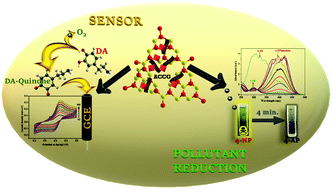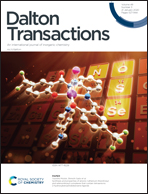Bi-functional Ag-CuxO/g-C3N4 hybrid catalysts for the reduction of 4-nitrophenol and the electrochemical detection of dopamine†
Abstract
The immense need to build highly efficient catalysts has always been at the forefront of environmental remediation research. Herein, we have synthesized dual-phase copper oxide containing Cu2O and CuO originating from the same reaction using hexamethyltetramine (HMT). Simultaneously, we coupled it with g-C3N4 (g-CN), constructing a triple synergetic heterojunction, which is reported significantly less often in the literature. Hydrothermal reactions led to the formation of various catalysts, namely, Ag-Cu2O-CuO-gCN (ACCG), Ag-CuO-gCN (ACG), Ag-Cu2O-CuO (ACC) and Ag-CuO (AC), which were thoroughly characterized via XRD and FESEM to gain structural, crystallographic and morphological insights. We clearly observed the pure phase formation of the catalysts and the development of sheet-like CuO and truncated octahedrons of Cu2O fused together within the g-CN framework. Also, XPS studies revealed the presence of copper in two different oxidation states, namely, Cu2+ and Cu+. BET analysis was performed to analyze the surface area and pore volume of the catalysts, which play very significant roles in catalytic reduction. The catalytic efficiencies of the catalysts were evaluated via the reduction of 100 ppm 4-nitrophenol (4-NP) to 4-aminophenol (4-AP) without using any light irradiation. The most efficient catalyst was ACCG, revealing the reduction of 4-NP in 4 minutes. Both Cu2O and g-CN played significant roles in reduction, following zero-order kinetics, unlike that which is often reported in the literature. We also evaluated the catalytic reduction with different concentrations of 4-NP and tuning the catalyst amount as well. A mechanism was postulated based on the XRD results of the post-catalytic reduction catalyst. The ACCG catalyst was also successfully tested as an effective dopamine sensor. The GC/ACCG electrode exhibited oxidation peak current density of 0.28 mA cm−2, which was much higher than those of the other catalysts. This unique combination of pure phase materials to form a composite as an effective catalyst as well as a sensor is an exclusive effort towards environmental remediation.



 Please wait while we load your content...
Please wait while we load your content...